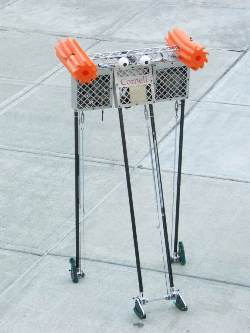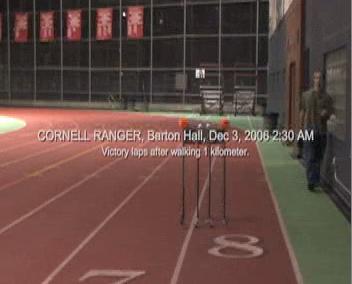High school student: Ben Oswald
Undergraduates: Carlos Arango, Steve Bagg, Megan Berry, Stephane
Constantin, Alex Gates, Matt Haberland, Sam Lee, Rubens Lee,
Andrew Mui, Andrew Spielberg
Graduate students: Ko Ihara, DaniŽl Karssen (visiting from
Delft), Gregg Stiesberg, Pranav Bhounsule
Lab Manager: Jason Cortell
Project Instructor: Andy Ruina
(Please let Andy know of any accidental omissions here)
Ranger 2006Ranger to Walk in Relay for Life on March 31, 2007 in honor of Gregg StiesbergSee also the Ranger 2011 Page
Starting at about 1:40 AM on Sunday December 3, 2006 in huge
Barton Hall at Cornell University walked just over 1 kilometer
(1003m +- 20m) without being touched by a person (except through
a slack safety cable).
That's 2868 steps, each about 36 cm long, over a period of about 40 minutes. Is this a world record?Please let us know of any distances you know of that any other walking robots or toys have gone without falling, help, or recharge. Catalog of Pictures |

|
|
Video: Robot Walking
Victory Laps
Download (50MB)  A 7-minute movie of Ranger walking some victory laps.
A 7-minute movie of Ranger walking some victory laps.(This movie is a bit boring, but that's part of why it's interesting). |
The TeamA report by DaniŽl Karssen, January 2006, containing lots of design details (PDF) Ranger is actually v2. Version 1, the Marathon Walker is described in this website by Matt Haberland. The Ranger Team (photos at semester start) Group Photo (At Semester End) |
More About the 2006 Ranger
The 5 kg Cornell Ranger carries about 80 watt-hours of batteries and
uses about 40 watts. Leg length is 1 m. It is steered by a hobby remote
control which slightly, ever so slightly, biases the steering to one
side or another by lifting one of the four feet slightly. The 1 km walk
was approximately 10 successive 100m circumference circles, with minor
radio-control corrections.With the present arrangement Ranger could go
about 3 km if it didn't trip on the sand-pit covers so often. And with a
doubling of the 0.5 kg battery pack, a weight it should be able to
manage easily, it could go 6 km. But we are not going to pursue this
until we make other design changes.
At present the ankle push-off motor/gearbox is undertorqued (a design mistake). One pair of feet can only lift a small fraction of body weight. Thus pre-emptive push off is not yet possible. And too much of the power is from hip torque which, because of the toggle-mechanism geometry of an extending foot and leg, actually contributes substantially to push-off. The specific energetic cost of transport is now about 1.6, much higher than the Collins Robot (0.2), but still relatively low in the robot world.
The control system is far from "passive". The information flow rate is perhaps 10,000 times greater than for the Collins robot. The basic control loop runs once every millisecond and many quantities are measured with at least 8 bit accuracy. And all three joints are controlled. But the control philosophy is still pretty dumb: push off when sensing heelstrike, pick up the foot, swing the leg forward, put the foot down, wait for heel strike, repeat. The robot has gyros but the controller hasn't yet made good use of them.
The machine has proven itself reliable in a basic design sense. Failures between construction completion on about Nov 15 and the Dec 3 have been non-fatal: a pulley jammed (needed one drop of oil, why was it shipped dry?), an H-bridge shorted (required PC board "brain" surgery to replace), motor-mount screws sheared off (how were we to know that the gearbox was supposed to be anchored and not the motor?), slipping feet were helped with addition of a cleat (spike). As of Dec 3 the robot has walked about 15 km between failures and falls.
A great feature of the machine is that control parameters can be sent wirelessly to the machine for quick trials. Meanwhile various torques, currents and angles can be read remotely on the fly.
With lower gears on the ankles and a more refined control we hope to reduce the power consumption to about 20 watts. If we also similarly improve the stability (control robustness) without losing the very good mechanical reliability, this machine could walk 12 km in one go without major redesign. We'll see.
At present the ankle push-off motor/gearbox is undertorqued (a design mistake). One pair of feet can only lift a small fraction of body weight. Thus pre-emptive push off is not yet possible. And too much of the power is from hip torque which, because of the toggle-mechanism geometry of an extending foot and leg, actually contributes substantially to push-off. The specific energetic cost of transport is now about 1.6, much higher than the Collins Robot (0.2), but still relatively low in the robot world.
The control system is far from "passive". The information flow rate is perhaps 10,000 times greater than for the Collins robot. The basic control loop runs once every millisecond and many quantities are measured with at least 8 bit accuracy. And all three joints are controlled. But the control philosophy is still pretty dumb: push off when sensing heelstrike, pick up the foot, swing the leg forward, put the foot down, wait for heel strike, repeat. The robot has gyros but the controller hasn't yet made good use of them.
The machine has proven itself reliable in a basic design sense. Failures between construction completion on about Nov 15 and the Dec 3 have been non-fatal: a pulley jammed (needed one drop of oil, why was it shipped dry?), an H-bridge shorted (required PC board "brain" surgery to replace), motor-mount screws sheared off (how were we to know that the gearbox was supposed to be anchored and not the motor?), slipping feet were helped with addition of a cleat (spike). As of Dec 3 the robot has walked about 15 km between failures and falls.
A great feature of the machine is that control parameters can be sent wirelessly to the machine for quick trials. Meanwhile various torques, currents and angles can be read remotely on the fly.
With lower gears on the ankles and a more refined control we hope to reduce the power consumption to about 20 watts. If we also similarly improve the stability (control robustness) without losing the very good mechanical reliability, this machine could walk 12 km in one go without major redesign. We'll see.
What Gives?
From a theoretical/scientific point of view this robot is less
interesting than the Collins machine. It has 4-legs instead of just two,
no knees, a less natural gait and it uses much more energy. But there is
a key difference. This one works day after day. Thus we can tune it and
learn from it. The goal is to get back to the grace and low-energy use
of the Collins robot, but with reliability. Meanwhile, as we work our
way there, this machine is perhaps a world record holder for robot
distance.